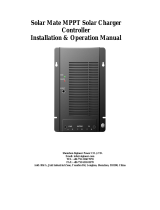
39TriStar MPPT Operator’s Manual
38
Operation
Certain battery types benet from a periodic boost charge to stir the electrolyte, level the cell
voltages, and complete the chemical reactions. Equalize charging raises the battery voltage
above the standard absorption voltage so that the electrolyte gases. The green SOC LED will
blink rapidly two (2) times per second during equalization charging.
The duration of the equalize charge is determined by the selected battery type. See table 4-1
in this section for more details. The Equalization Time is dened as time spent at the equalize
set-point. If there is insufcient charge current to reach the equalization voltage, the equalization
will terminate after an additional 60 minutes to avoid over gasing or heating the battery. If the
battery requires more time in equalization, an equalize can be requested using the TriStar Meter
or push-button to continue for one or more additional equalization cycles.
The Equalize set-point is temperature compensated if the RTS is connected; otherwise, voltages
set-points are based on the reference of 25ºC.
.
When to Equalize
The ideal frequency of equalizations depends on the battery type (lead-calcium, lead-antimony,
etc.), the depth of discharging, battery age, temperature, and other factors. One very broad
guide is to equalize ooded batteries every 1 to 3 months or every 5 to 10 deep discharges.
Some batteries, such as the L-16 group, will need more frequent equalizations.
The difference between the highest cell and lowest cell in a battery can also indicate the need
for an equalization. Either the specic gravity or the cell voltage can be measured. The battery
manufacturer can recommend the specic gravity or voltage values for your particular battery.
Why Equalize?
Routine equalization cycles are often vital to the performance and life of a battery - particularly
in a solar system. During battery discharge, sulfuric acid is consumed and soft lead sulfate
crystals form on the plates. If the battery remains in a partially discharged condition, the soft
crystals will turn into hard crystals over time. This process, called “lead sulfation,” causes the
crystals to become harder over time and more difcult to convert back to soft active materials.
Sulfation from chronic undercharging of the battery is the leading cause of battery failures in
solar charging systems. In addition to reducing the battery capacity, sulfate build-up is the
most common cause of buckling plates and cracked grids. Deep cycle batteries are particularly
susceptible to lead sulfation.
Normal charging of the battery can convert the sulfate back to the soft active material if the
battery is fully recharged. However, a solar charged battery is seldom completely recharged, so
the soft lead sulfate crystals harden over a period of time. Only a long controlled overcharge, or
equalization, at a higher voltage can reverse the hardening of sulfate crystals.
Preparation for Equalization
First, conrm that all of the system loads are rated for the equalization voltage. Consider that at
0°C (32°F) the equalization voltage will reach 16.75 Volts for 12 Volt L-16 batteries (67.0 Volts for
48 Volt systems) with a temperature sensor installed. Disconnect any loads at risk of damage
due to the high input voltage.
If Hydrocaps are used, be sure to remove them before starting an equalization. Replace the
Hydrocaps with standard battery cell caps. The Hydrocaps can get very hot during an equaliza-
tion. Also, if Hydrocaps are used, the equalization should be set for manual only (DIP switch #7
is Off).
After the equalization is nished, add distilled water to each cell to replace gasing losses. Check
that the battery plates are covered.
Equalize a Sealed Battery?
The Battery Charging Settings table (see table 4-1 in this section) shows two sealed battery set-
tings with an Equalization cycles. These are minimal “boost” cycles to level individual cells. This
is not an equalization, and will not vent gas from sealed batteries that require up to 14.4V charg-
ing (12V battery). Many VRLA batteries, including AGM and gel, have charging requirements up
to 14.4V (12V battery). Depending on the battery manufacturer’s recommendation, the “boost”
cycle for sealed cells can be disabled by setting the equalize setting switch to manual, if required.
Battery Charging Settings
Preset TriStar MPPT 150V battery charging options are shown in tables 4-1 and 4-2 below. All
voltage settings listed are for nominal 12 Volt batteries. Multiply the voltage settings by two (2) for
24 Volt batteries or by four (4) for 48 Volt systems.
NOTE: These settings are general guidelines for use at the operator’s discretion. The
TriStar MPPT 150V can be set or programmed to charge to virtually any specic
requirements, but only the battery manufacturer can recommend optimal settings for
their products.
Settings
Switches
4 - 5 - 6
Battery
Type
Absorp.
Stage
(Volts)
Float
Stage
(Volts)
Equalize
Stage
(Volts)
Absorp.
Time
(Minutes)
Equalize
Time
(Minutes)
Equalize
Interval
(Days)
off-off-off 1 - Gel 14.00 13.70 150
off-off-on 2 - Sealed* 14.15 13.70 14.40 150 60 28
off-on-off 3 - Sealed* 14.30 13.70 14.60 150 60 28
off-on-on 4 - AGM/Flooded 14.40 13.70 15.10 180 120 28
on-off-off 5 - Flooded 14.60 13.50 15.30 180 120 28
on-off-on 6 - Flooded 14.70 13.50 15.40 180 180 28
on-on-off 7 - L-16 15.40 13.40 16.00 180 180 14
on-on-on 8 - Custom Custom Custom Custom Custom Custom Custom
* “Sealed” battery type includes gel and AGM batteries
Table 4-1. Battery charging settings for each selectable battery type






















